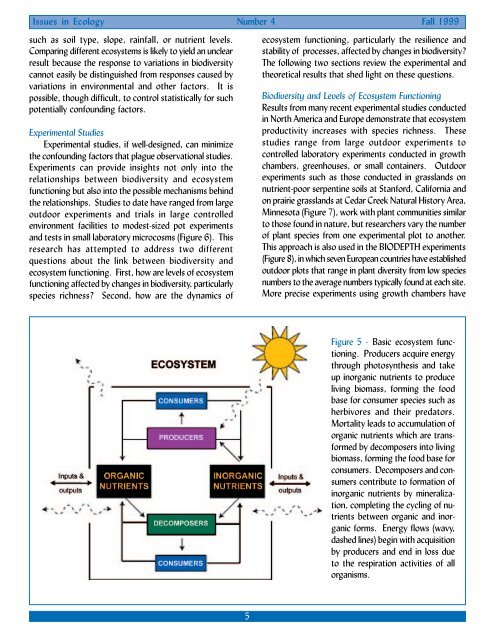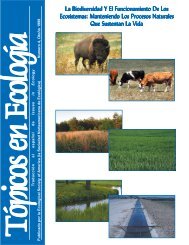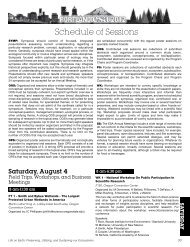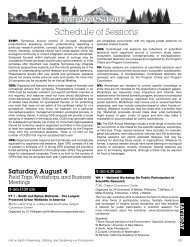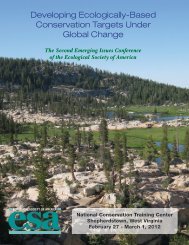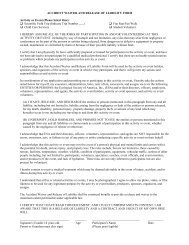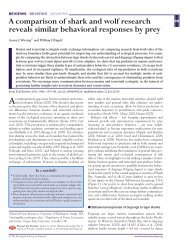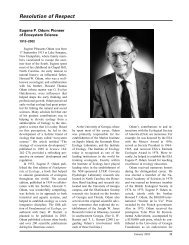Biodiversity and Ecosystem Functioning - Ecological Society of ...
Biodiversity and Ecosystem Functioning - Ecological Society of ...
Biodiversity and Ecosystem Functioning - Ecological Society of ...
You also want an ePaper? Increase the reach of your titles
YUMPU automatically turns print PDFs into web optimized ePapers that Google loves.
Issues in Ecology Number 4 Fall 1999<br />
such as soil type, slope, rainfall, or nutrient levels.<br />
Comparing different ecosystems is likely to yield an unclear<br />
result because the response to variations in biodiversity<br />
cannot easily be distinguished from responses caused by<br />
variations in environmental <strong>and</strong> other factors. It is<br />
possible, though difficult, to control statistically for such<br />
potentially confounding factors.<br />
Experimental Studies<br />
Experimental studies, if well-designed, can minimize<br />
the confounding factors that plague observational studies.<br />
Experiments can provide insights not only into the<br />
relationships between biodiversity <strong>and</strong> ecosystem<br />
functioning but also into the possible mechanisms behind<br />
the relationships. Studies to date have ranged from large<br />
outdoor experiments <strong>and</strong> trials in large controlled<br />
environment facilities to modest-sized pot experiments<br />
<strong>and</strong> tests in small laboratory microcosms (Figure 6). This<br />
research has attempted to address two different<br />
questions about the link between biodiversity <strong>and</strong><br />
ecosystem functioning. First, how are levels <strong>of</strong> ecosystem<br />
functioning affected by changes in biodiversity, particularly<br />
species richness? Second, how are the dynamics <strong>of</strong><br />
5<br />
ecosystem functioning, particularly the resilience <strong>and</strong><br />
stability <strong>of</strong> processes, affected by changes in biodiversity?<br />
The following two sections review the experimental <strong>and</strong><br />
theoretical results that shed light on these questions.<br />
<strong>Biodiversity</strong> <strong>and</strong> Levels <strong>of</strong> <strong>Ecosystem</strong> <strong>Functioning</strong><br />
Results from many recent experimental studies conducted<br />
in North America <strong>and</strong> Europe demonstrate that ecosystem<br />
productivity increases with species richness. These<br />
studies range from large outdoor experiments to<br />
controlled laboratory experiments conducted in growth<br />
chambers, greenhouses, or small containers. Outdoor<br />
experiments such as those conducted in grassl<strong>and</strong>s on<br />
nutrient-poor serpentine soils at Stanford, California <strong>and</strong><br />
on prairie grassl<strong>and</strong>s at Cedar Creek Natural History Area,<br />
Minnesota (Figure 7), work with plant communities similar<br />
to those found in nature, but researchers vary the number<br />
<strong>of</strong> plant species from one experimental plot to another.<br />
This approach is also used in the BIODEPTH experiments<br />
(Figure 8), in which seven European countries have established<br />
outdoor plots that range in plant diversity from low species<br />
numbers to the average numbers typically found at each site.<br />
More precise experiments using growth chambers have<br />
Figure 5 - Basic ecosystem functioning.<br />
Producers acquire energy<br />
through photosynthesis <strong>and</strong> take<br />
up inorganic nutrients to produce<br />
living biomass, forming the food<br />
base for consumer species such as<br />
herbivores <strong>and</strong> their predators.<br />
Mortality leads to accumulation <strong>of</strong><br />
organic nutrients which are transformed<br />
by decomposers into living<br />
biomass, forming the food base for<br />
consumers. Decomposers <strong>and</strong> consumers<br />
contribute to formation <strong>of</strong><br />
inorganic nutrients by mineralization,<br />
completing the cycling <strong>of</strong> nutrients<br />
between organic <strong>and</strong> inorganic<br />
forms. Energy flows (wavy,<br />
dashed lines) begin with acquisition<br />
by producers <strong>and</strong> end in loss due<br />
to the respiration activities <strong>of</strong> all<br />
organisms.


